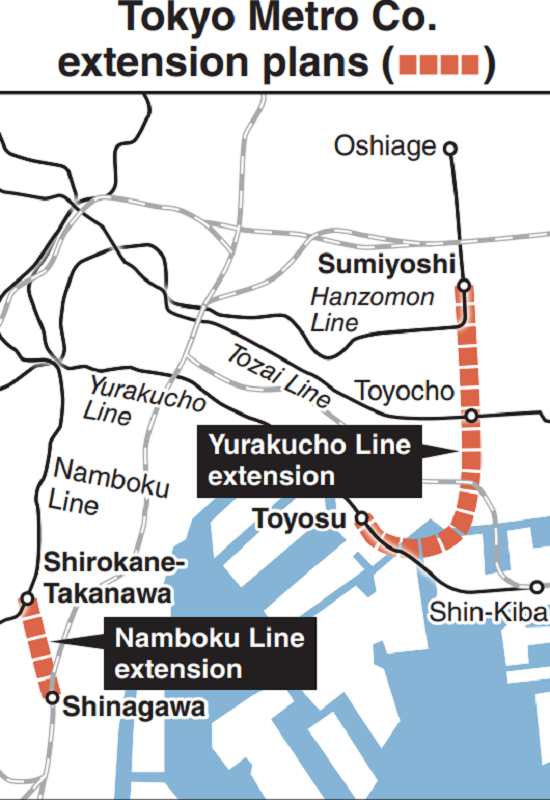
Tokyo Metro Co.’s Yurakucho Line trains are seen in Koto Ward, Tokyo. The subway line is expected to be extended from Toyosu Station to Sumiyoshi Station, both in the same ward.
15:06 JST, July 19, 2021

Projects to extend the Yurakucho and Namboku subway lines run by Tokyo Metro Co. will finally pick up steam, following a transport ministry panel’s proposals that have the company on track to go public.
The Council for Transport Policy has officially announced proposals calling on the central and Tokyo metropolitan governments to sell half of their respective shares in Tokyo Metro Co. to realize the railway operator’s stock listing.
The proposals were released July 15 by the Land, Infrastructure, Transport and Tourism Ministry.
Currently, 53.4% of all Tokyo Metro shares are held by the central government, with the remaining 46.6% owned by the metropolitan government. The proposals essentially take the form of agreements between the central and Tokyo governments and Tokyo Metro.
Each party will decide when to offer their shares, but there is a possibility that Tokyo Metro could be listed on the Tokyo Stock Exchange as early as fiscal 2022.
The proceeds from the sale of shares held by the central government will be earmarked for reconstruction measures for the 2011 Great East Japan Earthquake under a law to fund reconstruction measures.
The proposals included recommendations that Tokyo Metro extend the Yurakucho Line from Toyosu Station to Sumiyoshi Station, both in Koto Ward, and the Namboku Line from Shirokane-Takanawa Station to Shinagawa Station, both in Minato Ward.
The central and metropolitan governments should collectively hold half the shares of Tokyo Metro while the work is underway to extend the two lines in order to ensure that the extension work will be smoothly promoted, the proposals said.
To prevent Tokyo Metro’s financial situation from deteriorating, the central and metropolitan governments will support the railway operator with subsidies and other measures.
The transport ministry intends to include in its fiscal 2022 budget requests the necessary funding for surveys required ahead of the line extensions.
No Toei integration plan
The envisaged Namboku Line extension will in particular give the Shinagawa area a boost in its role as one of the gateways to central Tokyo.
“We want to move forward with preparations to sell up to half of Tokyo Metro shares currently held by the central government and metropolitan government,” Tokyo Gov. Yuriko Koike said Thursday during a videoconference with transport minister Kazuyoshi Akaba.
“We want to proceed with the plan in cooperation with the metropolitan government,” Akaba said.
The metropolitan government wants to extend the Yurakucho Line to improve transportation access to the Toyosu area, but for that purpose, it felt that holding onto its Tokyo Metro shares was essential.
On the other hand, the central government has been trying to sell its shares as soon as possible so it can allocate the proceeds to the reconstruction work ongoing in the aftermath of the 2011 Great East Japan Earthquake.
There was also a plan floated for the metropolitan government to buy the central government’s shares and integrate the operations of Tokyo Metro and the Toei subway lines run by the metropolitan government. But such a merger with the sluggish Toei subway could pose the risk of devaluing Tokyo Metro shares.
The central government was reluctant to let this integration go ahead, so in the end, the metropolitan government advanced the discussions on taking Tokyo Metro public.
Subsidies intended for project
Along with the listing, another pillar of the proposals is Tokyo Metro’s plan to extend the lines.
Regarding the extension of the Yurakucho Line, the ministry saw no prospect that it would become profitable, mainly because of a lack of commuters expected to use the extension. Tokyo Metro also said it would not build the extension.
The central government, however, believes the extension itself is necessary. The extension has started to move ahead because both the central and metropolitan governments indicated their intention to substantially reduce the expenditures through the use of subsidies.
“The central and metropolitan governments will provide subsidies and other support to realize the project [to extend the line] at an early date,” Koike said during Thursday’s meeting with Akaba.
The Namboku Line will be extended as part of the overall plan. Shinagawa Station is the gateway to central Tokyo for people using Haneda Airport and will also be the Tokyo departure station for the Linear Chuo Shinkansen Line, now under construction. East Japan Railway Co. (JR East) and Keikyu Corp., which are currently the only operators serving the station, are expediting efforts to redevelop the area around the station.
The central government has set a goal of 60 million visitors to Japan in 2030, so it sees great significance in the extension, which will increase access between Shinagawa Station and the city center. The hope is that demand for tourism from overseas visitors will rise significantly after the COVID-19 crisis is brought under control.
"Society" POPULAR ARTICLE
-

M4.9 Earthquake Hits Tokyo, Neighboring Prefectures
-

Israeli Tourists Refused Accommodation at Hotel in Japan’s Nagano Pref., Prompting Protest by Israeli Embassy and Probe by Prefecture
-

M7.5 Earthquake Hits Northern Japan; Tsunami Waves Observed in Hokkaido, Aomori and Iwate Prefectures
-

Tsukiji Market Urges Tourists to Avoid Visiting in Year-End
-

High School in Kyoto Says Students Shoplifted during Recent School Trip to Bali, Indonesia
JN ACCESS RANKING
-

Tokyo Economic Security Forum to Hold Inaugural Meeting Amid Tense Global Environment
-

Keidanren Chairman Yoshinobu Tsutsui Visits Kashiwazaki-Kariwa Nuclear Power Plant; Inspects New Emergency Safety System
-

Imports of Rare Earths from China Facing Delays, May Be Caused by Deterioration of Japan-China Relations
-

University of Tokyo Professor Discusses Japanese Economic Security in Interview Ahead of Forum
-

Japan Pulls out of Vietnam Nuclear Project, Complicating Hanoi’s Power Plans























